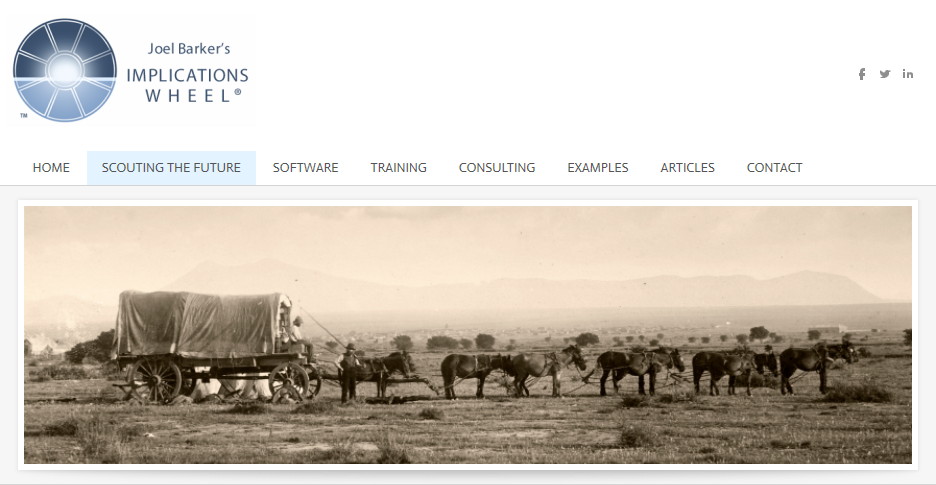Recall last article we defined futuring as a subset of strategic planning and it is the field of using a systematic process for thinking about and picturing possible futures and then setting the probability for each occurring. We also gave examples from 52 Trends Shaping Tomorrow’s World by Marvin Cetron and Owen Davies. If you were able to read Part 1, were you able to consider the implications of those thirteen trends for your organization?

In Part 2 we will discuss the systematic process. I will borrow from some of my favorite futurists to form an amalgam. Joel Barker (www.implicationswheel.com) gives us the analogy of early American pioneers using scouts. They helped wagon masters identify and prepare for the many risks and opportunities found “just over the horizon”. The scouting process proved to be valuable because it incorporated the following critical attributes:
Speed – scouts rode out, made observations and returned quickly so the information would be fresh
Scatter – multiple scouts were used so that a broad area could be covered and alternative pathways not overlooked
Sampling – scouts did not analyze everything to great detail. They returned with observations, impression and images qualified by their experience
Mapping – scouts mapped the terrain with sufficient detail to give the wagon master the “lay of the land”
The ultimate decision of which way to proceed was by the wagon master, not the scouts. But with the scouts’ input, the wagon master was able to make decisions with confidence regarding matters that had consequences far into the future. Joel thinks these attributes can serve an organization’s exploration for paths to a desired future and I agree.

So scouting helps us in the present to make bets on which current path will take us to the best expected future. Next we need to know how to explore various futures themselves, in the now. Ed Cornish’s book of the same title as this article is a great detailed source of tools. I will comment on some of the most common and valuable tools on how to explore various futures:
- Polling – consulting with other experts who are knowledgeable on the topic. This is what venture capitalists do so well and this helps filter through the current clutter and noise to get real possible futures in sharper focus
- Gaming – participants are placed in mock “future” situations and make decisions based on timed and controlled information, either in board games, computer simulations of the game or “maneuvers” just like in the military. Descriptions of operating in those futures is then constructed
- Modeling – use of the computer to run versions of models repetitively with minor variations to observe potential outcomes. This can help to see “weak signals” from the various futures before others do
- Visioning – picturing a desired future and what it will take to move there. This is what Steven Jobs of Apple excelled at
- Trend Surfing – looking for a set of related trends (just like incoming waves surfers traverse) and assessing new ideas in the context of those trends (i.e. who saw social media and smart phones converging in as early as 2003?)
- Trend Monitoring – continuous monitoring of emerging “unstoppable trends”. This is at the heart of General Electric’s Imagination Breakthroughs, their approach to innovation
- Trend Projection – where will a trend end up? Like last month’s article, where will a set of seemingly unrelated trends end up and what are their implications?
- Deja Viewing – reviewing the past to determine if something similar is emerging
- Experience Hitchhiking – like polling, this is “hitchhiking” with people who have gone through similar experiences already. This is the best way for novices to turn into experts as quickly as possible
- Scenarios – like Visioning, but futurists usually paint an Optimistic, Continuation, Pessimistic, Disaster and Miracle scenario around a challenge or opportunity for an organization, city or industry. A key is putting an expected probability of occurrence for each. Alternatively, futurists create a separate execution plan for each scenario and wait and see which scenario unfolds. Finally, futurists try to start implementing now the best scenario and assume it will become reality. This is referred to as “creating the future you want”
Futuring is not guaranteed to pay off – but it can in huge ways. The reality is your organization can practice futuring with just a little homework and not much money and for many it is just plain fun. Worried about getting the future wrong? Futurists feel that even hazy views of two or three possible futures and how to get there is better than simply waiting for the future to come upon you.

This article is part of a series on what causes a firm’s value to increase.
Dr. William Bigler is the founder and CEO of Bill Bigler Associates. He is a former Associate Professor of Strategy and the former MBA Program Director at Louisiana State University at Shreveport. He was the President of the Board of the Association for Strategic Planning in 2012 and served on the Board of Advisors for Nitro Security Inc. from 2003-2005. He has worked in the strategy departments of PricewaterhouseCoopers, the Hay Group, Ernst & Young and the Thomas Group. He can be reached at bill@billbigler.com or www.billbigler.com.
